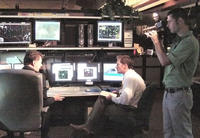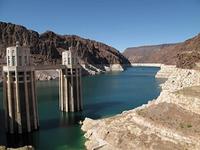-
Iron is key to reversing climate change
Scientists and politicians are trying to devise ways to reduce CO2 emissions — but when it comes to getting rid of the CO2 that is already there, nature itself plays an important role: carbon dioxide is removed from the atmosphere and safely trapped on the ocean floor through a natural reaction that fixes the molecule to organic carbon on the surface of large bodies of water
-
-
Millions of Americans at risk of flooding as sea levels rise
Nearly four million Americans, residing in a combined area larger than the state of Maryland, find themselves at risk of severe flooding as sea levels rise in the coming century, new research suggests; in terms of population, Florida is the most vulnerable, closely followed by Louisiana, California, New York, and New Jersey
-
-
iPads allow judges to sign warrants anywhere
Getting local judges to sign last minute warrants just got a lot easier with iPads
-
-
Molecule may aid nuclear waste clean-up
Scientists have produced a previously unseen uranium molecule in a move that could improve clean-up of nuclear waste
-
-
High manganese levels making air breathing dangerous in some areas
In residential neighborhoods near manufacturing industries, a breath of air may be more hazardous than refreshing; research finds manganese concentrations higher in residential neighborhoods than industrial sites, levels vary by region
-
-
If Japan-like disaster happened in U.S., results would be far worse
An estimated 20,000 people died or are still missing after a massive earthquake-induced tsunami struck Japan on 11 March 2011, yet some 200,000 people were in the inundation zone at the time; experts say that if the same magnitude earthquake and tsunami hits the Pacific Northwest, the death toll will be much higher because of the lack of comparable preparation; that 90 percent rate could be the number of victims, not survivors
-
-
Industry: current chemical safety standards sufficient, should be extended
DHS’s management of the U.S. chemical plant safety has come under criticism lately, but he Society of Chemical Manufactures and Affiliates (SOCMA) said it strongly supports U.S. chemical security standards; the industry associated noted that since the program’s 2007 launch, more than 2,000 facilities have changed processes or inventories such that they are no longer considered high-risk under the Chemical Facility Anti-Terrorism Standards (CFATS)
-
-
Better to use spray rather than a gun in bear encounters
Carrying a gun in bear country does not mean you are more protected in the event of a bear encounter; researchers say people should behave cautiously and carry bear spray instead
-
-
National Weather Service budget cuts threaten poor IT infrastructure

The Obama administration has proposed cutting more than $39 million from the National Weather Service’s (NWS) budget, particularly from its IT department, and critics worry that the cuts could cause the agency’s already crippling infrastructure problems to grow worse
-
-
Increase in groundwater demands due to climate change
As precipitation becomes less frequent due to climate change, lake and reservoir levels will drop and people will increasingly turn to groundwater for agricultural, industrial, and drinking water needs; the resource accounts for nearly half of all drinking water worldwide, but recharges at a much slower rate than aboveground water sources and in many cases is nonrenewable
-
-
Next-gen weather satellites to improve tornado warnings in South
More than a quarter of the 1,688 twisters confirmed across the United States in 2011 occurred in the four-state region of Alabama, Georgia, Mississippi, and Tennessee – and most of the 73 tornadoes hitting the United States in January 2012 occurred in those four states; southern tornadoes are especially insidious and challenging to track, and NASA’s weather satellites are now paying special attention to them
-
-
What U.S. can learn from EU chemicals law
U.S. industry and environmental groups agree that the Toxic Substances Control Act of 1976 needs to be modernized better to protect public health and the environment; there is no consensus, however, on what the reform should look like; researchers suggest that the United States may want to look at how the EU regulates chemicals
-
-
Asteroid 2011 AG5 worries to be justified – or not -- in February 2023
Asteroid 2011 AG5 is one of 8,744 near-Earth objects that have been discovered; it is approximately 460 feet (140 meters) in size; it is on a collision course with Earth for 5 February 2040 – but we will k now for sure in February of 2023, when it will pass Earth no closer than about one million miles, making it possible for scientists to plot its future trajectory
-
-
Future aircraft could capture, re-use some of their own power
When an Airbus 320 lands, a combination of its weight and speed gives it around three megawatts peak available power; researchers work on making the aircraft of tomorrow contribute to their power needs by harnessing energy from the wheel rotation of their landing gear to generate electricity
-
-
U.S. water shortages loom

More than 1 in 3 counties in the United States could face a “high” or “extreme” risk of water shortages due to climate change by the middle of the twenty-first century; 7 in 10 of the more than 3,100 U.S. counties could face “some” risk of shortages of fresh water for drinking, farming, and other uses
-
More headlines
The long view
How Climate Change Will Affect Conflict and U.S. Military Operations
“People talk about climate change as a threat multiplier,” said Karen Sudkamp, an associate director of the Infrastructure, Immigration, and Security Operations Program within the RAND Homeland Security Research Division. “But at what point do we need to start talking about the threat multiplier actually becoming a significant threat all its own?”
